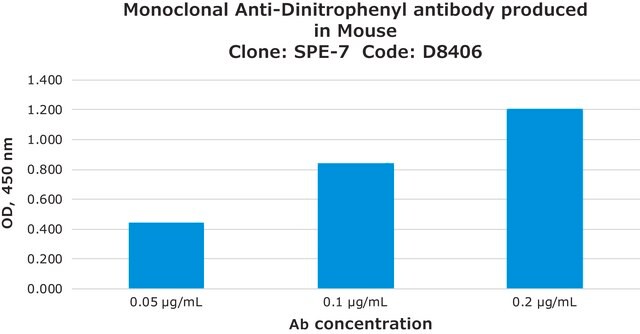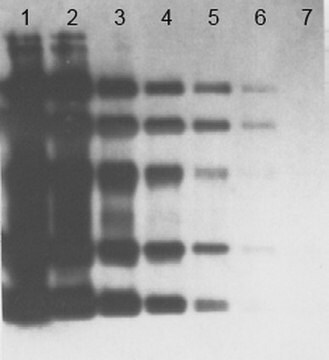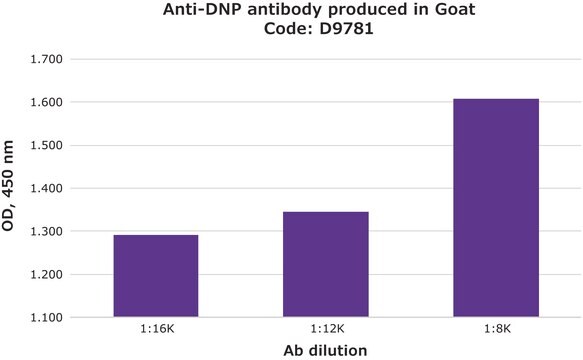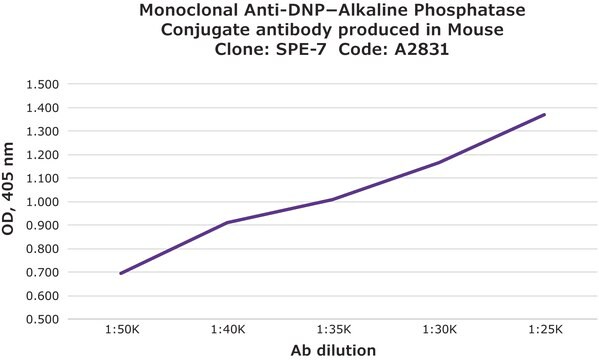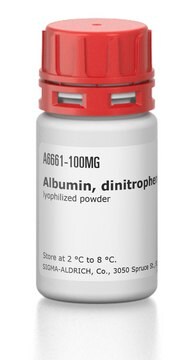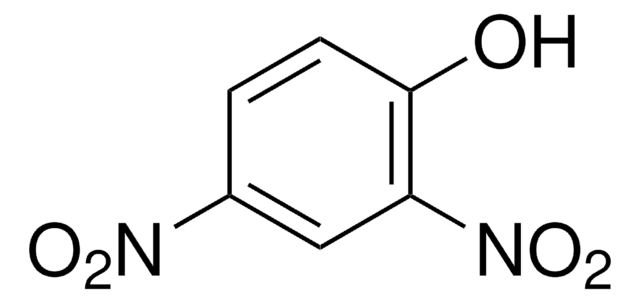MAB2223
Anti-DNP Antibody, clone 9H8.1
clone 9H8.1, from mouse
Synonym(s):
Dinitrophenol
Sign Into View Organizational & Contract Pricing
All Photos(1)
About This Item
UNSPSC Code:
12352203
eCl@ss:
32160702
NACRES:
NA.41
Recommended Products
biological source
mouse
Quality Level
antibody form
purified immunoglobulin
clone
9H8.1, monoclonal
species reactivity (predicted by homology)
all
technique(s)
western blot: suitable
isotype
IgG1κ
shipped in
wet ice
target post-translational modification
unmodified
General description
Dinitrophenol (DNP) is a small water-soluble, hydrophobic ligand that binds to transthyretin at acidic pH and also reduces the formation of amyloid fibril. DNP levels of 100 mg/l or more is greatly toxic to acclimated bacteria. DNP has been associated with possible therapies for neurodegenerative and neurological disorders.
Specificity
Demonstrated to react with a DNP moiety in a wider range of species. This antibody′s reactivity is expected to be species independent.
Immunogen
KLH-conjugated DNP
Application
This Anti-DNP Antibody, clone 9H8.1 is validated for use in WB for the detection of DNP.
Quality
Evaluated by Western Blot in Oxyblot protein standards.
Western Blot Analysis: 0.5 µg/mL of this antibody detected DNP on 10 µg of Oxyblot protein standards.
Western Blot Analysis: 0.5 µg/mL of this antibody detected DNP on 10 µg of Oxyblot protein standards.
Target description
Various kDa observed. The Oxyblot protein standards (S7151) were used to test this antibody. These standards are phosphorylase B, BSA, OVA, Carbonic Anhydrase, and trypsin inhibitor which all contain 1-3 DNP residues per protein.
Physical form
Format: Purified
Analysis Note
Control
Oxyblot protein standards
Oxyblot protein standards
Storage Class
12 - Non Combustible Liquids
wgk_germany
WGK 1
flash_point_f
Not applicable
flash_point_c
Not applicable
Certificates of Analysis (COA)
Search for Certificates of Analysis (COA) by entering the products Lot/Batch Number. Lot and Batch Numbers can be found on a product’s label following the words ‘Lot’ or ‘Batch’.
Already Own This Product?
Find documentation for the products that you have recently purchased in the Document Library.
Customers Also Viewed
Jennifer B M Steffen et al.
The Journal of experimental biology, 226(15) (2023-07-20)
Coastal environments commonly experience fluctuations in salinity and hypoxia-reoxygenation (H/R) stress that can negatively affect mitochondrial functions of marine organisms. Although intertidal bivalves are adapted to these conditions, the mechanisms that sustain mitochondrial integrity and function are not well understood.
Xiaoding Wang et al.
Cell death and differentiation, 25(12), 2181-2194 (2018-04-19)
Secretory and transmembrane proteins rely on proper function of the secretory pathway for folding, posttranslational modification, assembly, and secretion. Accumulation of misfolded proteins in the endoplasmic reticulum (ER) stimulates the unfolded protein response (UPR), which communicates between the ER and
Brígida R Pinho et al.
Free radical biology & medicine, 146, 372-382 (2019-11-22)
Abnormal protein homeostasis (proteostasis), dysfunctional mitochondria, and aberrant redox signalling are often associated in neurodegenerative disorders, such as Huntington's (HD), Alzheimer's and Parkinson's diseases. It remains incompletely understood, however, how changes in redox signalling affect proteostasis mechanisms, including protein degradation
Our team of scientists has experience in all areas of research including Life Science, Material Science, Chemical Synthesis, Chromatography, Analytical and many others.
Contact Technical Service
